
Asteroids is a multidirectional shooter video game developed and published by Atari for arcades. It was designed by Lyle Rains and Ed Logg. The player controls a single spaceship in an asteroid field which is periodically traversed by flying saucers. The object of the game is to shoot and destroy the asteroids and saucers, while not colliding with either, or being hit by the saucers' counter-fire. The game becomes harder as the number of asteroids increases.
The video game crash of 1983 was a large-scale recession in the video game industry that occurred from 1983 to 1985 in the United States. The crash was attributed to several factors, including market saturation in the number of video game consoles and available games, many of which were of poor quality. Waning interest in console games in favor of personal computers also played a role. Home video game revenue peaked at around $3.2 billion in 1983, then fell to around $100 million by 1985. The crash abruptly ended what is retrospectively considered the second generation of console video gaming in North America. To a lesser extent, the arcade video game market also weakened as the golden age of arcade video games came to an end.

Frogger is a 1981 arcade action game developed by Konami and published by Sega. In North America, it was distributed by Sega/Gremlin. The object of the game is to direct five frogs to their homes by dodging traffic on a busy road, then crossing a river by jumping on floating logs and alligators.

Breakout is an arcade video game developed and published by Atari, Inc. and released on May 13, 1976. Breakout was released in Japanese arcades by Namco. The game was designed by Nolan Bushnell and Steve Bristow and prototyped via discrete logic chips by Steve Wozniak with assistance from Steve Jobs. In the game, eight rows of bricks line the top portion of the screen, and the player's goal is to destroy the bricks by repeatedly bouncing a ball off a paddle into them. The concept was predated by Ramtek's Clean Sweep (1974), but the game's designers were influenced by Atari's Pong (1972). The arcade version of Breakout uses a monochrome display underneath a translucent colored overlay.

Paperboy is an action game developed and published by Atari Games and released as an arcade video game in 1985. The player takes the role of a paperboy who delivers a fictional newspaper called The Daily Sun along a street on his bicycle. The arcade version of the game featured bike handlebars as the controller.

Commando, released as Senjō no Ōkami in Japan, is a 1985 vertically scrolling run and gun video game developed and published by Capcom for arcades. The game was designed by Tokuro Fujiwara. It was distributed in North America by Data East, and in Europe by several companies including Capcom, Deith Leisure and Sega, S.A. SONIC. Versions were released for various home computers and video game consoles. It is unrelated to the 1985 film of the same name, which was released six months after the game.
The following article is a broad timeline of arcade video games.
1982 was the peak year for the golden age of arcade video games as well as the second generation of video game consoles. Many games were released that would spawn franchises, or at least sequels, including Dig Dug, Pole Position, Mr. Do!, Zaxxon, Q*bert, Time Pilot and Pitfall! The year's highest-grossing video game was Namco's arcade game Pac-Man, for the third year in a row, while the year's best-selling home system was the Atari 2600. Additional video game consoles added to a crowded market, notably the ColecoVision and Atari 5200. Troubles at Atari late in the year triggered the video game crash of 1983.

Bump 'n' Jump is an overhead-view vehicular combat game developed by Data East and originally released in Japan as Burnin' Rubber. Distributed in North America by Bally Midway, the arcade version was available as both a dedicated board and as part of Data East's DECO Cassette System. The goal is to drive to the end of a course while knocking enemy vehicles into the sides of the track and jumping over large obstacles such as bodies of water.
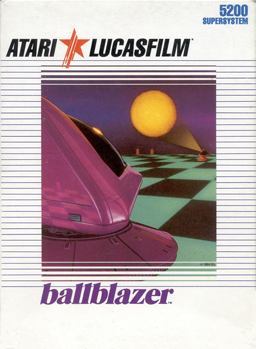
Ballblazer is a futuristic sports game created by Lucasfilm Games and published in 1985 by Epyx. Along with Rescue on Fractalus!, it was one of the initial pair of releases from Lucasfilm Games, Ballblazer was developed and first published for the Atari 8-bit computers. The principal creator and programmer was David Levine. The game was called Ballblaster during development; some pirated versions bear this name.
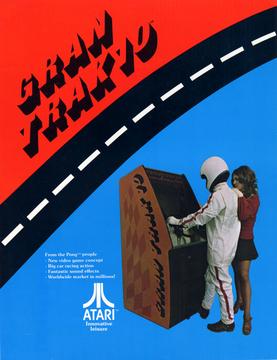
Gran Trak 10 is an arcade driving video game developed by Atari through its subsidiary Cyan Engineering, and released by Atari in May 1974. In the game, a single player drives a car along a race track, viewed from above, avoiding walls of pylons and trying to pass as many checkpoints as possible before time runs out. The game is controlled with a steering wheel, accelerator and brake pedals, and a gear stick, and the car crashes and spins if it hits a pylon.
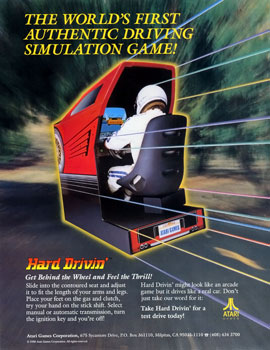
Hard Drivin' is a sim racing arcade video game developed by Atari Games in 1989. Players test drive a sports car on courses that emphasize stunts and speed. It features one of the first 3D polygon driving environments via a simulator cabinet with a haptic vibrating steering wheel and a custom rendering architecture.

Pac-Man is a 1982 maze video game developed and published by Atari, Inc. under official license by Namco, and an adaptation of the 1980 arcade game Pac-Man. The player controls the title character, who attempts to consume all of the wafers in a maze while avoiding four ghosts that pursue him. Eating flashing wafers at the corners of the screen causes the ghosts to temporarily turn blue and flee, allowing Pac-Man to eat them for bonus points. Once eaten, a ghost is reduced to a pair of eyes, which return to the center of the maze to be restored.

Indy 500 is a 1977 racing video game developed by Atari, Inc. for its Video Computer System. It is themed around the Indianapolis 500, and is based on Atari's earlier 8-player arcade game, Indy 800.
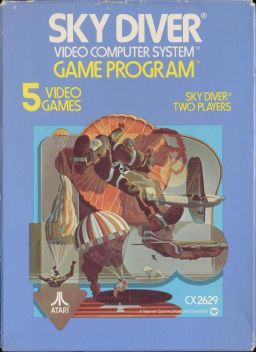
Sky Diver is an arcade video game designed by Owen Rubin, and released by Atari, Inc. in 1978. An Atari VCS port by Jim Huether was published in 1979. The game is a third-person view of a parachuting drop zone. Sky Diver is a two-player game, although one player can play.

Jet Fighter is an arcade shooter video game released in 1975 by Atari, Inc. It was distributed in Japan by Nakamura Seisakusho (Namco).

Stunt Cycle is an arcade video game by Atari, Inc., originally released in 1976. In the style of the Evel Knievel craze of the mid-1970s, the game allows the player to perform simulated motorcycle jumping stunts. The arcade cabinet is modeled like a real motorcycle handlebar, and the player twists the right side for acceleration. The monitor is a 19-inch black and white cathode-ray tube with a black and white overlay. It accommodates 1 player or 2 players alternating.

Steeplechase is a sports video game by released in arcades 1975 by Atari, Inc. Developed by Atari subsidiary Kee Games, it simulates a steeplechase-style horse race. It was distributed in Japan by Nakamura Seisakusho (Namco) in 1976.

Star Wars: The Empire Strikes Back is a scrolling shooter video game programmed by Rex Bradford for the Atari 2600 and published by Parker Brothers in 1982. It was the first licensed Star Wars video game. An Intellivision version was released in 1983.
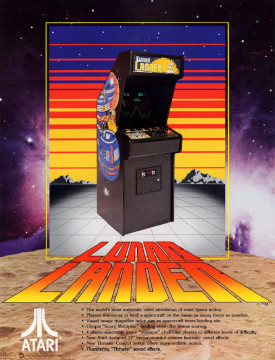
Lunar Lander is a single-player arcade game in the Lunar Lander subgenre. It was developed by Atari, Inc. and released in August 1979. It was the most popular version to date of the "Lunar Lander" concept, surpassing the prior Moonlander (1973) and numerous text-based games, and most later iterations of the concept are based on this Atari version.
















